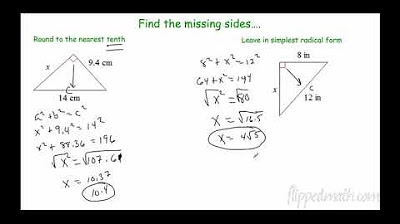How to Convert Fractions to Decimals
Summary
TLDRIn 'Math with Mr. J', the video demonstrates how to convert fractions to decimals through division, focusing on the numerator and denominator. It illustrates the process with examples, including 2/5 and 9/25, showing how to extend the division with decimals and zeros. The video also addresses rounding decimals to thousandths and handling repeating decimals, offering both rounding and the bar notation method to represent infinite repetition. The lesson concludes with converting an improper fraction, emphasizing the repeating pattern and rounding to the nearest thousandth.
Takeaways
- 📚 Converting a fraction to a decimal involves dividing the numerator by the denominator.
- 🔢 If the fraction is less than one, the decimal will also be less than one.
- ✏️ For fractions like 2/5, extend the division by adding a decimal and a zero to get a whole number result.
- 📉 For 9/25, the division process extends until a zero is reached, resulting in 36 hundredths.
- 🔄 When the division does not result in a zero, like with 1/3, the decimal repeats indefinitely.
- 📈 For fractions greater than one, such as 17/11, the decimal will be greater than one and may repeat.
- 📝 Proper fractions can be rounded to the nearest thousandth if needed, based on the context of the problem.
- 🔍 To round decimals, look at the digit in the thousandths place and the one next to it to decide whether to round up or down.
- 📉 Repeating decimals can be represented by writing the repeating digits and placing a bar over them.
- 📌 An improper fraction, like 17/20, results in a decimal that can be cut off at the hundredths place without rounding.
- 👍 The video concludes by summarizing the process of converting fractions to decimals and interpreting the results.
Q & A
What is the main topic of the video?
-The main topic of the video is how to convert a fraction to a decimal.
What is the basic method mentioned for converting fractions to decimals?
-The basic method mentioned for converting fractions to decimals is to divide the numerator by the denominator and round if needed.
What does the script suggest when the fraction is less than one?
-When the fraction is less than one, the script suggests that the decimal will also be less than a whole.
How does the script demonstrate converting 2/5 to a decimal?
-The script demonstrates converting 2/5 to a decimal by extending the division problem with a decimal and a zero, then dividing 20 by 5 to get 4, which means 2/5 is equal to 0.4.
What is the decimal equivalent of 9/25 according to the script?
-The decimal equivalent of 9/25 is 0.36, as the script shows by extending the division problem and dividing 90 by 25.
How does the script handle repeating decimals?
-The script handles repeating decimals by showing the pattern and suggesting to round to a certain place value or by using a bar over the repeating digits to indicate the repeating pattern.
What is the rounding rule mentioned in the script for decimals?
-The rounding rule mentioned in the script is to look at the digit in the thousands place and then look at the next digit to decide whether to round up or stay the same.
What does the script suggest for fractions that are greater than one?
-The script suggests that for fractions greater than one, the result when divided will be a decimal greater than a whole, and it provides an example of 17/11.
How does the script describe the conversion of 17/20 to a decimal?
-The script describes the conversion of 17/20 to a decimal as 0.85, which cuts off in the hundredths place and does not require rounding.
What is the significance of the bar in the context of repeating decimals as mentioned in the script?
-The bar in the context of repeating decimals signifies that the digit or sequence of digits under the bar will continue to repeat indefinitely.
What does the script advise for situations where decimals do not terminate or repeat in a simple pattern?
-The script advises to either round the decimal to a certain place value or use the bar method to indicate the repeating pattern for situations where decimals do not terminate or repeat in a simple pattern.
Outlines

هذا القسم متوفر فقط للمشتركين. يرجى الترقية للوصول إلى هذه الميزة.
قم بالترقية الآنMindmap

هذا القسم متوفر فقط للمشتركين. يرجى الترقية للوصول إلى هذه الميزة.
قم بالترقية الآنKeywords

هذا القسم متوفر فقط للمشتركين. يرجى الترقية للوصول إلى هذه الميزة.
قم بالترقية الآنHighlights

هذا القسم متوفر فقط للمشتركين. يرجى الترقية للوصول إلى هذه الميزة.
قم بالترقية الآنTranscripts

هذا القسم متوفر فقط للمشتركين. يرجى الترقية للوصول إلى هذه الميزة.
قم بالترقية الآنتصفح المزيد من مقاطع الفيديو ذات الصلة

The First Day of High School: Establishing Classroom Expectations and Building Relationships

Order of Operations: A Step-By-Step Guide | PEMDAS | Math with Mr. J

Jejak Matematika di Berbagai Budaya: Etnomatematika dalam Kehidupan Sehari-hari

Solving Two-Step Equations | Algebra Equations

(BOCORAN) SOAL TES MASUK SMP/MTs‼️PART 1

Lisa, wake up! - Conversation in English - English Communication Lesson

Geometry – 7.1 Pythagorean Theorem and Its Converse
5.0 / 5 (0 votes)
